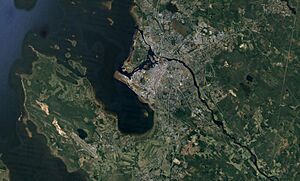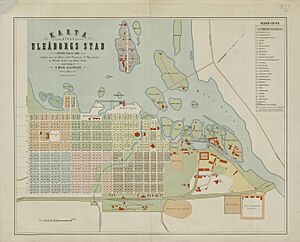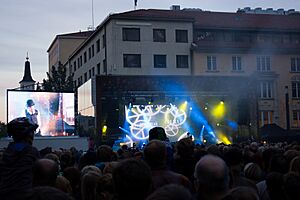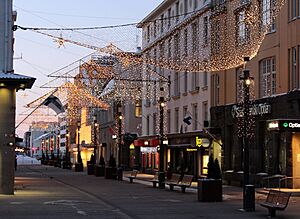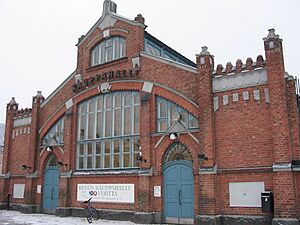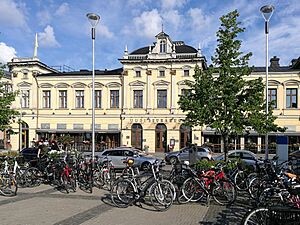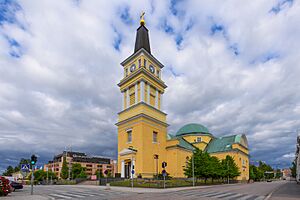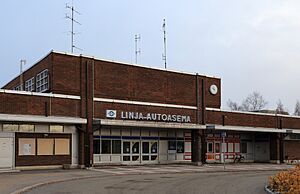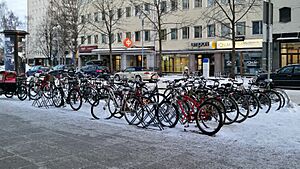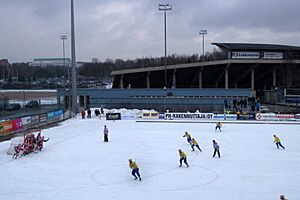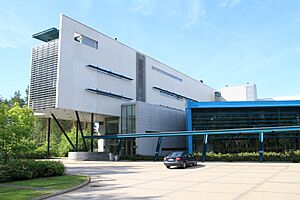Oulu facts for kids
Quick facts for kids
Oulu
Uleåborg (Swedish)
|
|||
|---|---|---|---|
|
City
|
|||
| Oulun kaupunki Uleåborgs stad City of Oulu |
|||

From top, left to right: Rantakatu in downtown Oulu; Oulu City Hall; Lyseo Upper Secondary School and the Oulu Cathedral; Shops along Kirkkokatu; Radisson Blu Hotel along Ojakatu
|
|||
|
|||
| Nickname(s):
Capital of Northern Finland; Capital of Northern Scandinavia
|
|||
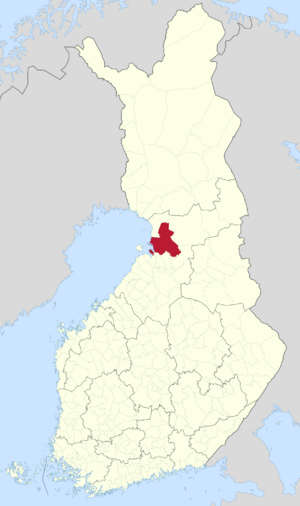
Location of Oulu in Finland
|
|||
| Country | Finland | ||
| Region | |||
| Sub-region | Oulu | ||
| Charter | 1605-04-08 | ||
| Area
(2018-01-01)
|
|||
| • City | 3,817.52 km2 (1,473.95 sq mi) | ||
| • Land | 2,972.44 km2 (1,147.67 sq mi) | ||
| • Water | 103.2 km2 (39.8 sq mi) | ||
| • Urban | 187.1 km2 (72.2 sq mi) | ||
| Area rank | 17th largest in Finland | ||
| Population
(2023-12-31)
|
|||
| • City | 214,633 | ||
| • Rank | 5th largest in Finland | ||
| • Density | 72.21/km2 (187.0/sq mi) | ||
| • Urban | 208 939 | ||
| • Urban density | 915.8/km2 (2,372/sq mi) | ||
| Demonym(s) | oululainen (Finnish) | ||
| Population by native language | |||
| • Finnish | 93.7% (official) | ||
| • Swedish | 0.2% | ||
| • Sami | 0.1% | ||
| • Others | 6% | ||
| Population by age | |||
| • 0 to 14 | 17.4% | ||
| • 15 to 64 | 66% | ||
| • 65 or older | 16.6% | ||
| Time zone | UTC+02:00 (EET) | ||
| • Summer (DST) | UTC+03:00 (EEST) | ||
Oulu (/ˈoʊluː/ OH-loo, Finnish: [ˈou̯lu]; Swedish: Uleåborg [ʉːlɛɔˈbɔrj]) is a city in Finland and the regional capital of North Ostrobothnia. It is located on the northwestern coast of the country at the mouth of the River Oulu. The population of Oulu is approximately 215,000, while the sub-region has a population of approximately 263,000. It is the 5th most populous municipality in Finland, and the fourth most populous urban area in the country. Oulu is also the most populous city in Northern Finland.
Oulu's neighbouring municipalities are: Hailuoto, Ii, Kempele, Liminka, Lumijoki, Muhos, Pudasjärvi, Tyrnävä and Utajärvi. Oulu is the third northernmost city in the world with a population of over 100,000, after Murmansk and Norilsk in Russia.
Due to its large population and geopolitical, economic and cultural-historical position, Oulu has been called the "capital of Northern Finland". Oulu is also considered one of Europe's "living labs", where residents experiment with new technologies (such as NFC tags and ubi-screens) on a community-wide scale. Although only in the top 2% of universities, the University of Oulu is regionally renowned in the field of information technology. Oulu has also been very successful in recent city image surveys; in a study published by the Finnish Economic Survey in 2008, Oulu received the best image rating among large cities in the country, including ratings from respondents in all provinces. In the 2023 T-Media survey, Oulu was tied with Kuopio as the second most attractive city in Finland, while Tampere was ranked first.
Once known for wood tar and salmon, Oulu has become a major high-tech centre, particularly in IT and wellness technology. Other important industries include wood processing, chemicals, pharmaceuticals, paper and steel.
Oulu has been selected as the European Capital of Culture for 2026.
Contents
Etymology
The city is named after the river Oulujoki, which originates in the lake Oulujärvi. There have been a number of other theories for the origin of the name Oulu. One possible source is a word in the Sami language meaning 'flood water', but there are other suggestions. At minimum, the structure of the word requires that, if originally given by speakers of a Uralic language, the name must be a derivative. In all likelihood, it also predates Finnish settlement and is thus a loanword from one of the now-extinct Saami languages once spoken in the area.
The most probable theory is that the name derives from the Finnish dialectal word oulu, meaning "floodwater", which is related to e.g. Southern Sami åulo, meaning "melted snow", åulot meaning "thaw" (of unknown ultimate origin). Two other word families have also been speculated to be related. The first is seen in the Northern Savo dialectal word uula and its Sami counterpart oalli, both meaning "river channel". The second is the Uralic root reconstructed as *uwa, meaning "river bed" (reflected as vuo in modern Finnish, also in derivatives such as vuolas "heavy-flowing"). To either of these roots, some Sami variety would have to be assumed having added further derivational suffixes.
History
Oulu is situated by the Gulf of Bothnia, at the mouth of river Oulujoki, which is an ancient trading site.
Following the Treaty of Nöteborg in 1323, the status of Oulu was disputed in its ownership, as both the Novgorod Republic and the Kingdom of Sweden held much influence. In 1345, the Kingdom of Sweden annexed territory up to the Kemi River for the Diocese of Turku. In 1375, the Novgorod Republic built a defensive castle which was later captured by the Kingdom of Sweden in 1377.
The 1400s were characterized by Russian raids in the region, during these raids captured people would be killed and/or taken back to the region of Russia. In 1531, the city was granted permission to act as a trading post. In 1590, the Oulu Castle was built by the Swedes and in 1595, the Treaty of Teusina firmly established Sweden's control over Oulu.
The city was founded on 8 April 1605 by King Charles IX of Sweden, and granted city privileges in 1610. In 1765, Oulu received township rights granting them to trade outside of Sweden. Oulu was the capital of the Province of Oulu from 1776 to 2009.
In 1822, a major fire destroyed much of the city, especially the city centre as most of the city was made from wood. The architect Carl Ludvig Engel, chiefly known for the neoclassical (empire style) buildings around Helsinki Senate Square, was enlisted to provide the plan for its rebuilding. With minor changes, this plan remains the basis for the layout of Oulu's town center. The Oulu Cathedral was built in 1832 to his designs, with the spire being finished in 1844. During the Åland War, part of the Crimean War, Oulu's harbour was raided by the British fleet, who destroyed ships and burned tar houses, leading to international criticism.
The city was the site of the Battle of Oulu on 3 February 1918 between the Whites and the Reds during the Finnish Civil War.
Geography
Oulu is located in northern Finland, a considerable distance from the other cities in the country. It is located 607 kilometres (377 mi) north of the capital city Helsinki. Mainland Finland's northernmost and southernmost points are roughly equidistant from Oulu. Oulu's coast sits at the Bothnian Bay (Perämeri in Finnish) and the Swedish mainland is about 180 km directly west across the Bothnian Bay. From the center of Oulu in the direction of Oulunsalo, there is Kempeleenlahti, a smaller but wide, meadow-belted bay, and part of it has been listed as a nature conservation area. The nearby island Hailuoto is just off the coast, 53 kilometres (33 mi) away in the Bothnian Bay. Along the coast to the southwest, about 75 kilometres (47 mi) of Oulu is Raahe (Brahestad), known for its historic wooden town, and, further to the southwest, about 130 kilometres (81 mi) of Oulu is Kalajoki, known for its popular sandy beaches.
Subdivisions
Oulu is divided into 106 city districts. The largest of these are Haukipudas, Oulunsalo, Kaakkuri, Ritaharju, Tuira, and Kello.
The municipality of Ylikiiminki was merged with the city of Oulu on 1 January 2009. Oulu and the municipalities of Haukipudas, Kiiminki, Oulunsalo, and Yli-Ii were merged on 1 January 2013.
Climate
Oulu has a subarctic climate (Köppen: Dfc), bordering a humid continental climate (Köppen: Dfb). It is the largest Finnish city entirely in this climatic zone as well as one of the largest such in the world. The typical features are cold and snowy winters with short and mild summers. Average annual temperature is 3.3 °C (37.9 °F). The average annual precipitation is 477 mm (18.78 in) falling 105 days per year, mostly in late summer and fall. The warmest temperature ever recorded in Oulu was 33.3 °C (91.9 °F) in July 1957, while the coldest temperature on record was −41.5 °C (−42.7 °F) in February 1966.
Due to Oulu's far northern location, and its frequent overcast skies, it only sees on average 15 minutes of sunshine per day in December. During the winter solstice days only last 3 hours and 34 minutes with the sun rising 1.9 degrees over the horizon. On the other hand, during the summer solstice days last 22 hours and 3 minutes, with the sun dipping 1 degree below the horizon. This gives Oulu white nights during the summer.
| Climate data for Oulu, 1991–2020 normals, records 1921–present | |||||||||||||
|---|---|---|---|---|---|---|---|---|---|---|---|---|---|
| Month | Jan | Feb | Mar | Apr | May | Jun | Jul | Aug | Sep | Oct | Nov | Dec | Year |
| Record high °C (°F) | 9.3 (48.7) |
7.8 (46.0) |
11.5 (52.7) |
23.9 (75.0) |
29.9 (85.8) |
32.3 (90.1) |
33.3 (91.9) |
30.5 (86.9) |
25.4 (77.7) |
21.1 (70.0) |
11.2 (52.2) |
8.2 (46.8) |
33.3 (91.9) |
| Mean daily maximum °C (°F) | −4.8 (23.4) |
−4.7 (23.5) |
−0.4 (31.3) |
5.8 (42.4) |
12.6 (54.7) |
17.9 (64.2) |
21.1 (70.0) |
18.9 (66.0) |
13.2 (55.8) |
5.8 (42.4) |
0.5 (32.9) |
−2.7 (27.1) |
6.9 (44.5) |
| Daily mean °C (°F) | −8.2 (17.2) |
−8.4 (16.9) |
−4.4 (24.1) |
1.6 (34.9) |
8.0 (46.4) |
13.7 (56.7) |
16.7 (62.1) |
14.6 (58.3) |
9.6 (49.3) |
3.3 (37.9) |
−1.6 (29.1) |
−5.3 (22.5) |
3.3 (38.0) |
| Mean daily minimum °C (°F) | −11.9 (10.6) |
−12.1 (10.2) |
−8.3 (17.1) |
−2.5 (27.5) |
3.4 (38.1) |
9.3 (48.7) |
12.4 (54.3) |
10.6 (51.1) |
6.0 (42.8) |
0.6 (33.1) |
−4.2 (24.4) |
−8.8 (16.2) |
−0.5 (31.2) |
| Record low °C (°F) | −37.5 (−35.5) |
−41.5 (−42.7) |
−32 (−26) |
−21.4 (−6.5) |
−9.1 (15.6) |
−6.1 (21.0) |
3.6 (38.5) |
−1.5 (29.3) |
−8.0 (17.6) |
−20.6 (−5.1) |
−33 (−27) |
−37.2 (−35.0) |
−41.5 (−42.7) |
| Average precipitation mm (inches) | 32 (1.3) |
29 (1.1) |
26 (1.0) |
23 (0.9) |
40 (1.6) |
51 (2.0) |
80 (3.1) |
62 (2.4) |
49 (1.9) |
51 (2.0) |
43 (1.7) |
39 (1.5) |
525 (20.5) |
| Average snowfall cm (inches) | 33 (13) |
46 (18) |
43 (17) |
7 (2.8) |
— | — | — | — | — | — | 4 (1.6) |
17 (6.7) |
150 (59) |
| Average precipitation days | 9 | 8 | 7 | 6 | 8 | 8 | 10 | 10 | 8 | 10 | 10 | 10 | 104 |
| Average relative humidity (%) (daily average) | 87 | 86 | 82 | 73 | 67 | 66 | 71 | 76 | 82 | 86 | 90 | 89 | 80 |
| Mean monthly sunshine hours | 24 | 69 | 137 | 208 | 273 | 296 | 283 | 212 | 133 | 69 | 28 | 8 | 1,740 |
| Average ultraviolet index | 0 | 0 | 1 | 2 | 3 | 4 | 4 | 3 | 2 | 1 | 0 | 0 | 2 |
| Source 1: FMI | |||||||||||||
| Source 2: FMI (record highs and lows 1921–1961)
FMI (record highs and lows 1961–present) Source 3: weather2travel.com (average monthly UV index) |
|||||||||||||
Demographics
Population
The city of Oulu has 214,633 inhabitants, making it the 5th most populous municipality in Finland. The Oulu region has a population of 262,736, making it the fourth largest region in Finland after Helsinki, Tampere and Turku. Oulu is home to 4% of Finland's population. 6.1% of the population has a foreign background, which is lower than in the major Finnish cities of Helsinki, Espoo, Tampere, Vantaa or Turku.
| Year | Population |
|---|---|
| 1980 |
121,809
|
| 1985 |
128,869
|
| 1990 |
136,029
|
| 1995 |
146,395
|
| 2000 |
160,851
|
| 2005 |
173,436
|
| 2010 |
185,419
|
| 2015 |
198,525
|
| 2020 |
207,327
|
Languages
Population by native language (2023) Finnish (93.7%) Russian (0.6%) Arabic (0.5%) English (0.5%) Chinese (0.4%) Farsi (0.3%) Somali (0.2%) Other (3.8%)
Oulu is the second largest monolingual Finnish-speaking municipality in Finland after Tampere. There are 497 Swedish speakers in Oulu, or 0.2% of the population. The number of Sámi speakers, Finland's third official language, is 155 inhabitants. As English and Swedish are compulsory school subjects, functional bilingualism or trilingualism acquired through language studies is not uncommon.
At least 100 different languages are spoken in Oulu. The most common foreign languages are Russian (0.6%), Arabic (0.5%), English (0.5%) and Chinese (0.4%).
Immigration
| Population by country of birth (2022) | ||
| Nationality | Population | % |
|---|---|---|
| Finland | 199,613 | 94.2 |
| Sweden | 1,913 | 0.9 |
| Soviet Union | 842 | 0.4 |
| China | 610 | 0.3 |
| Iraq | 528 | 0.2 |
| India | 509 | 0.2 |
| Vietnam | 377 | 0.2 |
| Thailand | 374 | 0.2 |
| Russia | 361 | 0.2 |
| Iran | 336 | 0.2 |
| Somalia | 311 | 0.1 |
| Other | 6,074 | 2.9 |
As of 2023[update], 13,040 people with a migrant background lived in Oulu, or 6.1% of the population. There are 13,986 residents who were born abroad, which or 6.5% of the population. The number of foreign citizens in Oulu is 9,405. Most foreign-born citizens come from the former Soviet Union, Sweden, Iraq, China and India.
The relative share of immigrants in Oulu's population is below the national average. Nevertheless, the city's new residents are increasingly of foreign origin. This will increase the proportion of foreign residents in the coming years.
Religion
In 2023, the Evangelical Lutheran Church was the largest religious group with 67.2% of the population of Oulu. Other religious groups accounted for 1.9% of the population. 30.9% of the population had no religious affiliation.
Economy


As of 31 December 2008, the active working population was employed as follows:
| Industries | Working population |
|---|---|
| Services | 43,049 |
| Industry | 11,111 |
| Commerce | 10,848 |
| Construction | 5,449 |
| Transport | 3,698 |
| Farming, forestry and mining | 582 |
| Unknown | 431 |
| Unemployment rate | 16.3% (2016) |
| Total | 75,158 |
In 2011, the most important employers were:
| Employer | No. of employees |
|---|---|
| City of Oulu | 9,709 |
| Northern Ostrobothnia Hospital District | 6,144 |
| University of Oulu | 3,045 |
| Nokia Networks | 2,100 |
| Nokia Group | 2,000 |
| The Oulu Region Joint Authority for Vocational Training | 1,955 |
| Kesko Group | 1,426 |
| Cooperative Arina Group (S Group) | 1,107 |
| Stora Enso Group | 1,155 |
| Itella Corporation | 780 |
| ISS Palvelut Oy | 730 |
| ODL Group | 653 |
Culture
The best known cultural exports of the city of Oulu are the Air Guitar World Championships held annually in August, Mieskuoro Huutajat (also known as Screaming Men), the now defunct metal band Sentenced, and one of the best ice hockey teams in Europe, Oulun Kärpät.
Many artists, writers, and musicians live in the city. A variety of concerts – rock, classical, and jazz – as well as other cultural events take place each year. Examples include the Oulu Music Video Festival, the Air Guitar World Championships, and the Musixine Music Film Competition, all in August. In July, the annual rock festival Qstock takes place. The Oulu Music Festival is held in winter and the Oulunsalo Music Festival in summer. The Irish Festival of Oulu takes place each October, and the International Children's Film Festival each November.
Museums in Oulu include the Northern Ostrobothnia museum, the Oulu Museum of Art (OMA), the Tietomaa science center, and the Turkansaari open-air museum.
Notable statues and sculptures in Oulu include a sculpture of Frans Michael Franzén and The Bobby at the Market Place statue.
Finlands' Eurovision representatives 2021 rock band Blind Channel are from Oulu. They placed 6th in the competition.
Kalmah is a melodic death metal-band from Oulu that formed in 1998.
Food
In the 1980s, rössypottu, salmon soup and sweet cheese (juhannusjuusto) were named Oulu's traditional parish dishes.
Sights
- Tietomaa, a science center with over 150 exhibits
- The Rapids Center, the area in the estuary of the Oulu river consisting of small islands connected with bridges and fountains in the middle of the river, and including a housing area of building blocks planned by Alvar Aalto
- The Market Square with the City Library, the City Theatre, the Toripolliisi statue and old salt and tar storehouses
- Hupisaaret Islands, a large park area located in the estuary of the Oulu river
- The F. M. Franzen memorial
- The Koitelinkoski rapids
- The Northern Ostrobothnia museum
- The Pateniemi Sawmill Museum
- The Vehicle Museum
- The University of Oulu Botanical Gardens (situated in Linnanmaa)
- The Arctic Gallery
- Technopolis, the technology village
- Turkansaari (historical open-air museum)
- Spa Hotel Eden and sand beach in Nallikari recreation and tourism area
- Mannerheim Park
- Old observatory in Linnansaari, built in 1875 on top of the ruins of the Castle of Oulu
- Oulu Museum of Art
Churches
- Cathedral
- Haukipudas Church
- Holy Family of Nazareth Church
- Holy Trinity Cathedral of Oulu
- Kiiminki Church
- Oulujoki Church
- Oulunsalo Church
- St. Luke's Chapel
- Tuira Church
- Ylikiiminki Church
Other points of interest
- Qstock music festival
- Oulu Music Video Festival
- Air Guitar World Championships
- Jalometalli Metal Music Festival
- The Irish Festival of Oulu
- Laitakari beacon tower
- Madetoja Hall, housing the Oulu Music Centre, the residence of the Oulu Symphony Orchestra
- Oulu Hall (a large indoor sports facility consisting of a low dome, which looks somewhat like a landed flying saucer)
- Terwa Marathon & Run, event in late May (since 1989)
- The Terva-skiing event in early March (since 1889)
- The Winter Swimming World Championship
Transport
Intercity
Oulu is served by Oulu Airport, the second largest airport in Finland by passenger volume. It is located 15 kilometres (9 mi) south-west of the city centre.
The Port of Oulu is one of the busiest harbours on the Bothnian Bay. It includes four separate harbour areas: Vihreäsaari oil and bulk docks, Nuottasaari docks and Oritkari docks. There is also a ferry service in Oulu, which is mostly used between Oulunsalo and the Hailuoto Island.
The shortest travel time from Oulu railway station to Helsinki Central railway station is 5 h 34 min, operated by VR. Other destinations include Kolari, Rovaniemi, Seinäjoki and Tampere.
The most important road in Oulu is Highway 4 (E8/E75) that runs from Helsinki to Utsjoki via Lahti, Jyväskylä, Oulu, Kemi and Rovaniemi. Other highways running to and from Oulu are Highway 20 to Kuusamo and Highway 22 to Kajaani.
Within the city
Oulu is notable for its transportation network dedicated to non-motor vehicular traffic, including pedestrians and bicycles (termed "light" traffic in Finland). In 2022, the city contained more than 950 kilometres (590 mi) of pathways and more than 300 underpasses and bridges devoted exclusively to pedestrian and bicycle traffic. The network is used year-round. The ratio of walking and cycling traffic pathways to residents is the highest in Finland and the cycling mode share is 20 percent.
Even in winter, bicycle commuting remains strong in Oulu, in spite of the cold, dark, and snow. About 12% of winter trips are by bicycle, and about half of trips to school or university are. The city has a robust system for keeping bike paths maintained and clear of snow, and bike paths and lanes are plowed before roadways to encourage such human-scale winter transit in the city where 12% already do so. The Winter Cycling Federation was founded in Oulu in 2013, and the first Winter Cycling Congress was held there.
In 2015, a large underground parking facility, Kivisydän (Stone Heart), opened in the city center directly beneath main shopping streets. The network of parallel roads for cars and pedestrians was drilled in the rock at the depth of 30 meters (98 ft). The parking facility includes two ramps, 900 visitor parking lots (expandable to 1500), six access points to the ground served by 19 elevators (expandable to nine and 25), a service facility for commercial delivery vehicles, and ubi-screens that guide the driver to the selected ground access point and help locate the parked car by its license number.
Solar power
In 2015, the Kaleva Media printing plant in Oulu became the most powerful photovoltaic solar plant in Finland, with 1,604 solar photovoltaic (PV) units on its roof. Although the city of Oulu, located near the Arctic Circle, has only two hours of weak sunlight in December, the photovoltaic cells work almost around the clock in the summer. The cold climate means the PV panels can get up to a 25% boost per hour, as they don't overheat.
Because the sun is quite low in the sky at this latitude, vertical PV installations are popular on the sides of buildings. These solar walls also capture light reflected from snow.
Snow is not necessarily cleared from rooftop solar installations.
The local utility, Oulun Energia, is owned by the city of Oulu. The energy mix it receives from the Nordic-wide grid includes wood pellets, waste incineration, bioenergy, hydro-electric, geothermal, wind, nuclear, peat, natural gas and coal.
Sports
Ice hockey is the most popular spectator sport in Oulu. The local club Kärpät has won the SM-liiga championship title eight times (1981, 2004, 2005, 2007, 2008, 2014, 2015 and 2018). It has also twice been the runner-up in the IIHF European Champions Cup, in 2005 and in 2006.
In football AC Oulu plays in Veikkausliiga, the premier division of Finnish football. So far OPS has claimed the Finnish football championship only twice by winning Mestaruussarja in 1979 and in 1980. Other notable football clubs include OLS, OTP and JS Hercules.
Oulu has one well-known bandy club, OLS, which plays in Bandyliiga and has become Finnish champions 14 times, most recently in 2014. The other bandy club, OPS, with its 7 championships and a bronze medal as late as in 2009, announced it would be closing down after the 2009–10 season. In 2001 the city was the main venue for the Bandy World Championship.
Oulu is also home to several other sports clubs such as Oulu Northern Lights (American football), Oulun NMKY (Basketball), Oulun Lippo (Pesäpallo), Oulun Pyrintö (Track and field), SK Pohjantähti (Orienteering)), OYUS (Rugby union), Oulu Irish Elks (Gaelic football) and ETTA (Volleyball).
Oulun Tervahiihto is an annual ski marathon event held since 1889.
Terwa Run & Marathon is an annual running event held since 1989 in late May.
A former motorcycle speedway track known as the Iinat Motor Sports Center was located north of the Pirttilammentie and east of the Iinatintie (64°57′31″N 25°34′23″E / 64.95861°N 25.57306°E). The Center opened in 1979 and hosted many events, including the Finnish Final, as part of the qualifying round of the Speedway World Championship in 1983.
Education
The University of Oulu and Oulu University of Applied Sciences have their main campuses located in Oulu.
Oulu is home to the most northerly architecture school in the world. The school is best known for its strong regionalistic ideas for developing architecture. This movement is named "the Oulu school" ("Oulun koulu") of architecture.
Oulu Vocational College has over 13 000 students. It houses several different study subjects in different units which are spread over Oulu and neighbouring municipalities. Oulu Vocational College School of Business Studies is one of the few vocational schools which has game programming in its curriculum.
Oulu International School is one of nine schools in Finland offering basic education in English. There's also a Swedish-speaking private school (Swedish Svenska Privatskolan i Uleåborg) for students up until high school. The school is the northernmost Swedish-speaking school in Finland.
Notable people
- Saara Aalto, singer, X Factor UK finalist
- Eero Aho, actor
- Outi Alanko-Kahiluoto, politician
- Marcus Amand, Finnish-French racing driver
- Peter von Bagh, film historian and director
- Blind Channel, a post-hardcore and nu metal band
- Vladislav Delay, electronic musician
- Eeva Riitta Fingerroos, Paralympic swimmer
- Frans Michael Franzén, poet
- Lars Gallenius, 17th century painter
- Heidi Hautala, politician
- Matti Hautamäki, ski jumper
- Aaro Hellaakoski, poet
- John von Julin, pharmacist, factory owner and vuorineuvos
- Yrjö Kallinen, politician
- Jorma Kontio, harness driver
- Pekka Korpi, harness driver
- V.A. Koskenniemi, poet
- Ville Laihiala, musician and former frontman of the discontinued local metal band Sentenced
- Vilho Lampi, painter
- Fanni Luukkonen, the leader of Lotta Svärd
- Leevi Madetoja, composer
- Iivo Niskanen, Olympic champion cross-country skier
- Kerttu Niskanen, cross-country skier
- Patrik Pasma, racing driver
- Leena Peltonen-Palotie, geneticist
- Susanna Pöykiö, figure skater
- Ville Ranta, comic artist
- Mika Ronkainen, filmmaker
- Keke Rosberg, 1982 Formula One world champion
- Kauko Röyhkä, author and rock musician
- Martti Suosalo, singer and actor
- Mikael Toppelius, church painter
- Juha Väätäinen, athlete
- Sara Wacklin, teacher and writer
- Three former presidents of the country Kaarlo Juho Ståhlberg, Kyösti Kallio and Martti Ahtisaari, also a Nobel Peace Prize laureate
- Ice Hockey players: Kari Jalonen, Mikael Granlund, Markus Granlund, Joni Pitkänen, Reijo Ruotsalainen, Mika Pyörälä, Lasse Kukkonen, Markus Nutivaara and Sebastian Aho
- Football/soccer players: Rasmus Karjalainen, Otso Liimatta, Aki Lahtinen, Antti Niemi, Markus Heikkinen, Janne Hietanen, Mika Nurmela and Seppo Pyykkö
- Qiyu Zhou, chess player, commentator, and streamer
International relations
Twin towns and sister cities
Oulu is twinned with:
- Alta Municipality, Norway (since 1948)
- Arkhangelsk, Russia (since 1993)
- Astana, Kazakhstan (since 2013)
- Boden, Sweden (since 1948)
- Bursa, Turkey (since 1978)
- Halle, Germany (since 1968)
- Leverkusen, Germany (since 1968)
- Odesa, Ukraine (since 1957)
- Siófok, Hungary (since 1978)
- Hangzhou, China (since 2010)
Oulu also maintains relationships with cities twinned to former municipalities merged with Oulu in 2013:
- Matera, Italy (twinned with Oulunsalo since 2010)
- Szigetszentmiklós, Hungary (twinned with Haukipudas since 1992)
- Kronstadt, Russia (twinned with Haukipudas, Kiiminki, and Yli-Ii since 1991)
Partnership and twinning cities
In addition Oulu has eight 'Partnership & Twinning cities':
International municipal projects
The educational department was a part of the Lifelong Learning Programme 2007–2013 in Finland.
See also
 In Spanish: Oulu para niños
In Spanish: Oulu para niños





